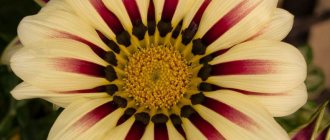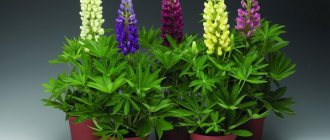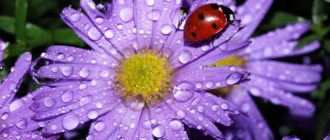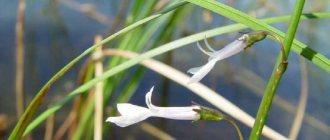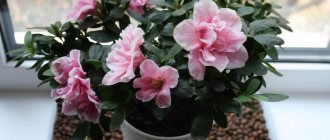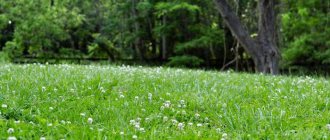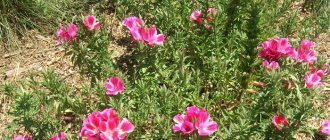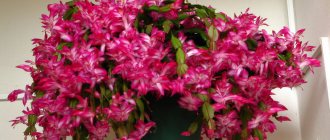Salvia sparkling
Everyone knows the name sage, but its second name seems outlandish and unusual to many. The fact is that in Russia it is customary to call the spicy and medicinal plant sage, and all ornamental plants - salvia.
Salvia
According to one version, the second name comes from the Latin “salvare”, which means “to save”. And it’s true, salvia is a real savior, the healing properties of which have been known to humanity for centuries. Medicinal sage has been cultivated since the time of the Roman Empire, using this miracle plant to treat colds, sore throats, toothaches and much more.
According to another version, the name “salvia” comes from the Latin “salvus”, which means “to be healthy”. And not in vain: in ancient times they said: “plant sage in the garden - you will not need doctors.”
By the way, not only doctors and healers admired sage, but also poets who wrote wonderful songs and poems about it. I will not quote ancient poets, but I will gladly quote an excerpt from the poems of our contemporary Vasily Fedorchenko:
Playful fairies drank hot, rejuvenating tea from fragrant grass. And they jokingly called the grass “shal-fairy” in honor of their loved ones. Well, how could it be otherwise? And they whispered spells, preparing decoctions for baths, and lotions for eyelids, and potions for the illness of any kind person, and a strong infusion for mysterious damage. And that grass grew in their reserved garden, Where fairies secretly grew magic sage. And no one heard, saw or knew why they were so smart and beautiful.
Beautiful, is not it?
Depending on the type and variety, salvia can grow in height from 30 cm to 1.5 m; stems tetrahedral, leaves opposite in pairs; flowers can be of different shapes and colors: red, lilac, blue, yellow, purple, white or pink.
Ads by
Description of salvia, types
All species of this flower, and there are almost 900 of them, are extremely light-loving. Florists call salvia species that are grown exclusively for decorative purposes. Wild-growing individuals are known to everyone under the name “sage”, which is used in cooking and in healing practice.
The shoots of the plant are tetrahedral, erect (sometimes ascending), the height depends on the specific variety, and ranges from 20 to 120 cm. The leaf blades are usually entire, but can also be pinnately dissected. Their outer side is dark green, and the lower side is whitish.
The ends of the shoots are decorated with complex whorled inflorescences, consisting of small flowers and resembling a spike. Sometimes it can look like a panicle and reach a length of 20 cm.
All available types of salvia, depending on biological characteristics and agrotechnical characteristics, can be divided into 3 groups:
- Subtropical species that are cultivated as annuals in the middle zone. They need warmth and constant hydration. May die in light frosts.
- Mediterranean varieties are more frost-resistant and can withstand drought. However, they need loose soil and mineral fertilizers.
- This includes all frost-resistant species . They bloom lushly in the second year, and only need shelter when natural cover is scanty.
Popular varieties
In city flower beds and private flower beds you can often find the bright colors of annual salvia of various colors. Flower growers are most willing to fill their flower beds with the following varieties:
Salvia sparkling
Salvia sparkling is a perennial plant, but in the middle zone it is cultivated as an annual. Compact bushes have a height of 20-80 cm and have fairly dense foliage. The opposite petiolate leaves are ovoid in shape and dark green.
Large flowers of irregular shape are endowed with a double perianth. In addition to the usual red color for this species, others are also often found: pink, white, purple. Salvias bloom from June until the first frost.
The varieties Salvator, Sahara, and Fire Star are very popular.
Salvia vermilion
Straight branching shoots of salvia grow 50-70 cm. The green mass has dense pubescence on the underside, and the front side of the finely serrated leaves is bare. A loose inflorescence of whorled flowers can reach 30 cm in length. Salvia blooms in July and pleases the eye until frost.
Among the popular varieties are: Sherry Bloss, Lady in Red.
Salvia powdery
The pyramidal bush can reach a height of 90 cm. Mealy salvia is quite unpretentious and blooms for a long time. Plants of this species are large - tall peduncles have long inflorescences with 2 centimeter flowers.
Flowering of this type of salvia begins in August. Most often the flowers are blue, but some varieties bloom white.
Flower growers fell in love with the following varieties: Anschuld, Victoria, Strata.
Salvia green
The only decorative variety of green or variegated salvia is Horminum. There are many soft pink flowers on long simple inflorescences. They are very effectively set off by bracts that have rich pink or purple tones.
Popular varieties are: Pink Sandy, Oxford Blue, White Swan.
Salvia whorled
The bush with ascending shoots and dense pubescence is small - only about 40 cm. The leaf blades have an unusual shape; dense whorls contain up to 30 blue-lilac flowers.
The most striking representative of Salvia whorled is the Purple Rain variety.
Salvia dandelionifolia
This herbaceous plant has a basal leaf rosette. Each part of salvia is endowed with a pleasant aroma. The leaves are pinnately dissected, their undersides are pubescent. Simple inflorescences are quite long and can reach 30 cm.
Properties of medicinal sage - harm and benefit
Medicinal properties of sage
The most famous species of the Salvia genus is medicinal sage (lat. Salvia officinalis) , which is known to almost everyone who suffered from toothache and gumboils. This plant with oblong leaves and purple inflorescences reaches a height of 50 cm. The species has been in cultivation since 1597. The following varieties and garden forms of Salvia officinalis have been bred for decorative floriculture:
- Purpurascens is a plant with purple-violet leaves;
- Crim de la Crime is a variety with variegated leaves;
- Tricolor is a plant with beige-yellow leaves with purple splashes.
As a medicinal plant, sage is widely used in folk medicine. Hippocrates also pointed out its healing properties, who recommended taking the plant to prolong youth and restore strength. Sage inflorescences and leaves contain essential oil, which includes linalool, aromatic resins, acetic and formic acid, flavonoids, tannins and pinene. The roots of the plant contain coumarin, and the seeds contain fatty oil. Thanks to its composition, sage has a pronounced antimicrobial, restorative, anti-inflammatory, emollient, diuretic, antiseptic, astringent, antipyretic and hemostatic effect, it can reduce sweating and increase the amount of gastric juice, increasing the secretory activity of the digestive organs.
The healing properties of sage determine the use of its preparations in the treatment of kidney and liver diseases, digestive organs, viral infections, sore throat, mumps, gingivitis, neuritis, polyarthritis, radiculitis, tuberculosis, pneumonia, pyelonephritis, diabetes, headaches and gynecological diseases. And when used externally, sage helps heal wounds, ulcers, boils, burns, frostbite and skin diseases.
The leaves and tops of sage stems are harvested as medicinal raw materials, from which decoctions, extracts and essential oils are made.
Salvia officinalis - contraindications
Sage is an excellent remedy for many diseases, but it is not suitable for everyone. Plant preparations can cause allergic reactions, so a skin test must be performed before using them. Sage is contraindicated for women during pregnancy and breastfeeding: it can reduce the level of milk production, and sometimes the use of sage preparations leads to convulsions. Sage should not be used for epilepsy, severe cough and acute kidney inflammation.
In addition, it is unacceptable to take medications for more than three months, as this can lead to addiction and cause irritation of the mucous membranes. In any case, before using sage preparations, it is better to consult a doctor.
2.6 Rating 2.60 (15 Votes)
- Back
- Forward
How to grow salvia from seeds
To grow healthy seedlings, gardeners need seeds, soil, container, diligence, and attention.
Preparing seeds for sowing
Since salvia seeds do not need stratification, preparation of planting material is carried out on the eve of planting. Seed material can be purchased or collected personally. Sometimes bagged goods are already pre-processed and granulated; in this case, it does not need pre-planting treatment and is sown directly into the soil.
However, it should be noted that granular seeds need to be planted a little earlier than usual, since it takes some time to dissolve the artificial mineral shell.
Simple seeds are subjected to the following treatments:
- Germination test. Place the seeds in a deep plate with warm water for 1.5 hours. Then the water with floating pacifiers is drained. High-quality seeds are collected at the bottom.
- Disinfection. The grains wrapped in a piece of bandage are kept in manganese for a third of an hour, followed by washing.
- Drying. Before planting, the seeds are dried on a sheet of paper. To prevent the core from drying out, do not place the grains on the battery.
Selection of soil mixture
If you don’t want to buy ready-made soil, it’s easy to prepare it yourself. Salvia puts forward the following requirements for it: nutritional value, lightness, water permeability.
You will need coarse sand, peat and leaf soil. A well-mixed mixture will need to be re-sowed twice:
- Place on a large sieve;
- Place in a fine sieve.
The containers are filled as follows:
- The very bottom is lined with expanded clay, approximately 1 cm thick;
- Half the container is filled with coarse soil;
- Next, add fine soil.
To destroy possible pests, the soil is watered with hot, strong potassium permanganate and left to rest for a week.
Sowing salvia seedlings in containers
Any low container is suitable for salvia seedlings. To prevent stagnation of water, the bottom is pierced several times. Ready-made factory containers already have holes and are equipped with pallets.
- The soil is pre-moistened so that the seeds stick better. Some gardeners mix salvia seeds with sand to ensure more uniform planting and prevent thickening. Granular material is larger and easier to sow, so the seeds are placed in a 3x3 pattern.
- The spread out seeds are lightly sprinkled with earth. Often gardeners simply press them lightly into the soil. The container is covered with glass or film.
Seeds germinate within 8-12 days. The temperature is maintained around +22ºС. The sprouts almost always emerge with a seed cap, and it is advisable to help them get rid of it.
How to sow salvia, the best way - video
Herbs
Perennial grasses
Sedge Morrow Variegata
Ophiopogon flat-arrowed
foxtail pinnately
Hakonechloa
Gray fescue
Imperata
Caring for salvia seedlings
The emerged seedlings begin to open gradually, lifting the glass for a short time, increasing it daily.
Lighting
Seedlings need light for 12 hours, so additional lighting is indispensable. The container can be placed on window sills, but be sure to turn on additional phytolamps in the morning and evening.
Humidity and watering
From the moment of sowing and in the future, the soil should not be allowed to dry out. Moisten the seedlings with a spray bottle, or by pouring water into trays, from where it is absorbed into the soil through the drainage holes.
Excess moisture causes rotting of the roots, so it is better to dust the surface with ash.
Feeding
3 weeks after germination it is useful to feed them. Use complex formulations purchased in stores. To activate the growth of salvia, use Fertika and Agricola fertilizers.
Picking
For salvia, as for any seedling, a strong root system is very important. This can be achieved by double picking.
The first peak occurs during the period of 1-1.5 months of plant life. This is not too late, since salvias are slow-growing. In any case, diving is not done earlier than before the appearance of 2 permanent leaves.
Transplantation is usually carried out into the same containers, only at a greater distance. Can also be transplanted into individual containers. The distance is maintained at about 7 cm; deepen to the cotyledon leaves. Picked seedlings should be covered with paper for a couple of days.
3 weeks after the first pick, the procedure is repeated. The containers chosen are sufficiently capacious, since salvia roots grow well.
Picking salvia allows you to solve problems that will be useful to the plant throughout its life:
- Root development is stimulated;
- During picking, it is possible to select the strongest plants;
- Interweaving and, as a consequence, deformation of the roots are prevented;
- When picking, seedlings are examined to identify diseases and prevent them;
- Seedlings that begin to outgrow are buried a little deeper to slow down their growth if it is too early to plant.
After 4-5 leaves appear, the top of the seedling is pinched, causing maximum tillering. A couple of weeks after picking, salvias notice increased growth.
How to properly pick salvia seedlings - video
Possible diseases and pests, ways to get rid of them
Salvia is one of the few flowering herbaceous plants that practically do not get sick and are not negatively affected by pests. The flower is quite resilient, with strong immunity. The only danger for it is improper care: excessive humidity and low temperatures during the flowering period.
Under such circumstances, the plant may be susceptible to fungal diseases and mold. If moldy areas appear around the bush, the soil is treated with sulfur-containing substances.
Some of the few possible diseases of salvia:
| Problem | Signs | Fighting methods |
| Downy mildew | A white coating appears on the inside of the leaf, and brownish-yellow areas appear on the outside. Under this influence, the foliage begins to turn yellow, dry out and fall off. | The bushes are treated with preparations containing copper. |
| Black leg and rot on roots | The roots turn black, rot, and the root collar dies. This can happen due to poor-quality or waterlogged soil, most likely already containing fungal pathogens at the time of planting. | You can get rid of the problem by transplanting the plant to another area with more nutritious and healthy soil. You can also disinfect the soil with a weak solution of potassium permanganate before planting salvia, and regular application of mineral mixtures will help ensure nutritional value. |
| Aphids, whiteflies, spider mites, slugs and snails | Aphids settle on the stems and foliage of a plant, sucking nutrients from it. In addition, aphids are carriers of viral infections. Other small harmful parasites also attack the plant, eating their green mass. Spider mites envelop leaves with small, thin webs. | Spraying with insecticides such as Topaz, Prestige, Respect will help in pest control. You can also use the old proven method - spraying the plant with a soap solution. Slugs and snails should only be dealt with manually. |
When to replant salvia in open ground
Like all heat-loving crops, salvia does not like frost, so it is planted only after stable heat has developed. In the middle regions this is approximately the first ten days of June.
The planting holes need to be spacious so that the roots do not clump together. Add superphosphate or ash and a handful of humus to each hole. It is better to plant during periods of less sun activity, or shade the seedlings for 3 days.
When choosing a place for salvia, you need to pay attention to some nuances and immediately make adjustments for the location:
- Salvia is prone to lodging. The seedlings are either covered with soil or planted thicker.
- The activity of flower development may interfere with other plants. You need to maintain a distance of 30 cm.
Popular varieties
Low varieties of cineraria usually reach 30-40 cm in height and are most often found on sale, but there are varieties that grow up to 80 cm. It is worth paying attention to this when purchasing.
Interesting varieties of silver cineraria:
- "Candicans" Candicans - the variety grows up to 30 cm, excellent for flower beds and edging.
- "Silverdust" Silverdust is a popular low-growing variety with heavily pubescent leaves. Bushes quickly and has beautiful, matte leaves. It grows well and is distinguished by uniform silver coloring of the leaves.
- “Diamond” Diamond – grows larger than the Silverdust variety, to a height of 30-35 cm, not counting the peduncles. Produces characteristic, deeply lobed leaves with an impressive silvery color.
- “Alice” Alice is a low-growing ashthorn (30 cm).
- “Dusty Miller” Dusty Miller is a medium-growing variety (45 cm).
- "Cirrus" Cirrus is a variety with grayish leaves.
Possible problems with seedlings and their solutions
Salvias are practically not susceptible to any diseases. The damage is caused by insects and slugs, which can be successfully combated using traditional methods. Often, when growing seedlings, gardeners are faced with some unpleasant situations:
- Shoots do not appear for a long time . This situation can be observed if the swollen seeds were still overdried. It is best to sow again, since even if the previous seeds sprout, the sprouts will not be completely healthy.
- The sprouts stay in their caps for a long time. Seed skins remain on plants for a long time if the seed material is not of high quality. The seedlings should be slightly moistened and, using a toothpick, help get rid of the seed coat. Then the seedlings are fed with complex microelements.
- Flowering is delayed or completely absent . If the plant has pale foliage and the stems are very elongated, it means the whole problem is a lack of light. Salvias are quite demanding about this: no light - no color. If the problem is noticed at the beginning of summer, then you can try to transplant to a sunnier area. If the bush develops normally, the color is natural, rich, and there are few or no buds, then the salvia is simply fattening from excess nitrogen. In this case, it is sprayed with superphosphate.
Why does the plant dry out?
If you do not properly care for flower seedlings, the leaves will begin to turn yellow and fall off. As a result, the plant may dry out.
The reasons why foliage begins to turn yellow may be the following factors:
- improperly selected soil cover;
- pouring the soil layer;
- too bright lighting or too much sun.
Yellowing of foliage can be affected by a cold draft. Therefore, when growing a flower, you need to monitor temperature indicators. Due to low humidity or lack of moisture, the plant may dry out. To correct the situation, it is necessary to normalize the irrigation regime.
How to properly care for salvia in summer
Salvia is very easy to care for. Simple standard procedures include watering, weeding, mulching, loosening, and fertilizing.
What to feed for abundant flowering
In order for salvia to delight with an abundance of color, it needs proper nutrition. In the flowerbed, flowers are fertilized 5-7 days after planting. The menu offers her growth stimulants and minerals. As soon as the plant begins to form buds, the next feeding is carried out.
Salvia will bloom abundantly if it manages to develop its above-ground part well. Like nothing else, this is facilitated by nitrogen, found in proper quantities in bird droppings, humus, and manure.
The infusion of such organic matter should be poured over the transplanted salvias, and in a very short time they will become much healthier. Flowering is also promoted by potassium, which helps absorb water and phosphorus, which ensures normal development.
Salvia Cassiopeia
Some flower growers who do not have the proper experience and are poorly versed in various fertilizers can use tips from manufacturers. Many nutritional compositions speak for themselves: Ovary, Bud, and so on.
Experienced flower growers prefer traditional methods to all factory-made fertilizers. To prolong and enhance flowering, they use an ash solution. Also pour boiling water over the skin of bananas and peel potatoes for a week.
Before the buds open, it is useful for salvia to water it with water infused with egg shells.
Reproduction methods
Salvia reproduces in several ways. Perennial varieties can be divided from the rhizome, propagated by cuttings, and sown by seeds. But one-year-olds and biennials are propagated exclusively by seeds: direct sowing and through seedlings.
Seeds are sown in spring and autumn, before winter. However, there are varieties that can only be grown using seedlings. These are all varieties belonging to the type of salvia sparkling.
When and how to collect your seeds
High-quality material will be obtained exclusively from varietal flowers. Fading inflorescences are cut and dried. Do this not in the sun. The inflorescences are laid out under a canopy in the fresh air or in a ventilated room. You can collect a lot of seeds from dried seed pods.
Reproduction
The most popular method, as for many other ornamental plants, is cuttings . Although, salvia can be propagated in other common ways.
As a rule, perennials are propagated using cuttings.
Shoots can be harvested at any time of the year. Semi-lignified fragments about 15 cm long are used as cuttings. The shoots take root in a container with water, and after 3 weeks they are transplanted to the ground.
Salvia can also be propagated by layering . The plant branch is simply bent to the ground and secured with a metal bracket. After a few months, it develops its own small root system. Next, the cuttings are separated from the main bush and transplanted to their own permanent place.
The seed method is usually used for annual plants. As mentioned at the beginning of the article, you don’t have to bother with seedlings and plant the seeds directly in open ground. It is permissible to carry out the procedure even closer to winter. But it is still recommended to pre-grow seedlings.
How to grow perennial salvia
These flowers are planted once, and they will delight you with their blooms every year. There is no need to tinker with seedlings or prepare beds for direct sowing every time. Perennials are planted in metropolitan areas, in dachas, and can be found in meadows under natural growing conditions.
They are distinguished by a more powerful root system, which allows the plant to take care of itself, extracting precious moisture from the deep layers of the soil. Their stems are thicker, often with already lignified shoots.
Popular types
The most popular perennials planted in city flower beds are:
- Salvia oakberry. The stems of the plant are relatively low - only up to 60 centimeters. The lower petiole plates are always larger than the sessile ones located above. The inflorescences consist of several lateral branches.
The standard predominant color of the flowers is blue-violet, but the rather large purple bracts often catch the eye. The flowering of the Salvia oak grove species lasts 2.5-3 months: from late June to mid-September.
Plumosa
The most popular varieties are Amethyst (pink-violet), Mainakht (blue-violet), Plumosa (lavender).
- Salvia sticky. The bushes grow quite large - almost 1 meter. The flower has a large number of pubescent glandular shoots. The leaves are more like triangles of yellow-green color with a serrated edge. Salvias bloom towards the end of summer and bloom until frost.
Salvia glutinosa
- Salvia
nemorosa '
Rose Queen'
.
The low half-meter bush is distinguished by its long flowering time. Spike-shaped inflorescences can have different shades, depending on the variety
Salvia Rose Queen
Popular varieties are: snow-white Snow Hill, and dwarf varieties - Blue Queen (lavender), Rose Queen (pink).
Perennials include popular species of Ethiopian salvia and meadow salvia.
Features of cultivation and care
Perennial salvias are more difficult to care for. Many inexperienced flower growers are often perplexed about this, because, it would seem, there is no need to bother with seedlings and the plants are much hardier. However, not everything is so simple: perennials need sanitary and formative pruning, preparation for successful wintering.
In the spring, the bush is formed by cutting off shoots that are too elongated, not allowing them to become bare. After flowering has finished, all inflorescences should be removed. Just before the cold weather, all the old stems are cut off from the plant, leaving small stumps with buds, as well as young greenery.
It is advisable to cover the salvia for winter dormancy - if the winter has little snow and frost, the roots of the crop may be damaged and the flowering next year will not be so generous. Flower beds are covered with sawdust, spruce branches, and dry leaves.
Requirements for planting site and soil
Cineraria is not too demanding, but for it to be truly beautiful, it needs to be provided with proper growing conditions.
The species requires planting in a sunny place; only in full sun do the bushes form silvery decorative pubescence.
In shaded areas, the color of the leaves will be green, which will make them less decorative. Ashtray is able to grow in fairly dry areas. Only after planting is it necessary to regularly water the seedlings to help them take root.
Ashgrass has low requirements and does well in any garden soil. However, if we want to grow it as a perennial, then we need to provide a fertile, permeable substrate.
The soil for cineraria should be:
- fertile;
- permeable;
- humus;
- with a neutral or slightly acidic pH (pH 6-7.3).
Salvia in the flowerbed and flower beds - photo
Salvia is a very popular flower. It is most often planted in flower beds and flower beds. Salvia looks good in flowerpots or garden containers, which can be placed on balconies and well-lit garden areas. Bright salvia goes well with many types of ornamental plants: lobelia, marigolds, petunia, zinnia, ageratum, alyssum, silver cineraria.
Salvia combined with lobelia
Salvia with marigolds
Perennial Salvia
Salvia with cineraria
Salvia brillianti
Salvia horminum
Salvia Purple
Where to buy and cost of the plant
The flower can be purchased at any flower shop and nursery that specializes in growing garden plants. The cost of salvia seeds varies between 25 rubles. The price for seedlings reaches approximately 290 rubles. and higher.
To successfully cultivate salvia, you do not need to devote much time to the plant. You only need to follow the agrotechnical rules that relate to the regime of watering, loosening and mulching of the soil cover. Flower varieties and their photographs will tell you what fertilizers are best to feed the plant so that it blooms profusely.
Rules for creating compositions
An important condition when creating flower arrangements is to use predominantly low-growing plants, so that over time you do not end up with a hedge instead of a border. That is why the shortest ones are planted closer to the edge.
A few simple rules will help you create a flower border when decorating paths on your site:
- plants that are planted as edging should be of contrasting shades;
- provide a reserve of space for the possible growth of low-growing perennials;
- The boundaries of the borders can be trimmed with special garden shears, but it is better to choose crops with weak growth, then the paths will remain with clear edges for a long time.
Garden paths are decorated with edgings, mixborders and borders using a wide variety of plants, and without studying the characteristics of growing each of them, a positive result is not guaranteed.
Reviews from gardeners
natabu:
I grew my own sage from seeds. I don't remember the variety now. It germinates very easily at room temperature, sowing is superficial, previkur is required from ChN. She dived and pinched the top. When it became clear from the seedlings that there was not enough room for them in a 200 ml glass, I began to feed them with 0.5 doses of Kemira - an all-rounder. It grew so much that I barely made it to disembarkation at the OG. In theory, it is better to sow later, in March, for example. But I will continue to sow in the same way so that it blooms earlier.
Sourcesadiba.com.ua
AlinkaS:
I received this sage as a gift more than 10 years ago, although not a varietal one, but a species one. It easily covered about 3 winters, then no, it survived them too, it just froze about halfway. In the spring I cut it off and it grew again and bloomed every year.
Source websad.ru
